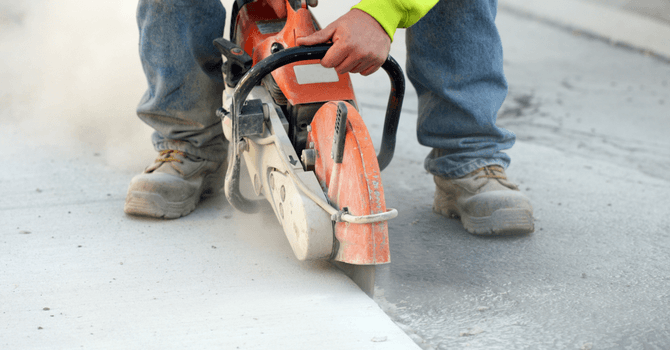Contractor, Cost, and Workflow of an Asbestos Decontamination
By Cynthia Pigeon
Updated on August 27, 2024

If you suspect your home may be contaminated with asbestos, it's better to be safe than sorry. Nowadays, there are numerous ways to determine whether or not there’s asbestos in your home, so if your suspicions are correct, experts in the field can tackle your home’s decontamination.
What’s Asbestos?
Asbestos is a generic term used when referring to several varieties of naturally occurring fibrous minerals, which can be found in nature. For a fibre to be classified as such, the particle must meet precise specifications: it must be more than 5 micrometres in length (µm) with a length-to-width ratio of at least 3 to 1.
The different varieties of asbestos are divided into 2 groups:
Serpentine: These fibres are long, flexible, and curved, and are found in chrysotile, also known as white asbestos. They're mainly used in manufacturing departments.
Amphibole: Fibres of this type of asbestos are, in contrast, rigid and straight. These features make them fragile and limit their commercial use. They include crocidolite (blue asbestos), amosite (brown asbestos), actinolite, anthophyllite, and tremolite.
Areas where asbestos may still be found:
There was a time not that long ago when asbestos wasn't considered a hazardous material. Quite the contrary, in fact, asbestos was listed as a component in many of the most popular items in the construction market, such as exterior cladding, pipe insulation, ceiling panels, and floor tiles. Asbestos was used to improve insulation and fire resistance. In products such as cement and plastic, asbestos was used as a strengthening agent.
Therefore, still today, we find asbestos in the basement, attics, and walls of many houses built mainly between the 30s and the 90s, that is, before the material was formally banned.
Outside of the construction industry, asbestos is also found in a wide range of products, such as friction materials, pre-1997 clothing, furnaces, industrial heating systems, as well as some fabrics.
Want to learn more about the decontamination process? Check out our article!
Hiring a Qualified Asbestos Removal Contractor

Source: MetsikGarden - Pixabay
Although there's no specific certification attesting to one's capacity to carry out an asbestos decontamination process, some boxes can still be ticked:
The contractor of your choosing has obtained the appropriate license by way of Régie du bâtiment du Québec.
The contractor has received proper asbestos decontamination training and has the necessary skills to carry out the project.
The contractor is prepared to meet the requirements set out in the Safety Code for the construction industry for asbestos-related work.
The contractor's "record" is clean, both with the Office de la protection du consommateur and with the Régie du bâtiment du Québec.
The contractor's quote is clear in every respect and he commits, in writing, to comply with the health protection standards in place.
Want additional information about vermiculite? Check out our article Everything You Need to Know About Vermiculite.
Decontamination: Types of Contractor Licenses
There are 4 types of licenses (issued by the Régie du bâtiment du Québec) that a contractor can have to prove that they're able to carry out an asbestos decontamination procedure.
If you're a trade contractor, you'll need to be licensed as either a "Sitework” (2.7) or "Insulation, Waterproofing, Roofing and Siding” (7.0) contractor.
On the other hand, if you're a general contractor, your license must state "Small buildings” (1.2) or "All buildings" contractor.
Want to know more about the subject matter? Check out our article. (French only)
Asbestos Abatement: Workflow
This procedure is law-regulated, as is the equipment used during the procedure. Thus, to ensure the health and safety of everyone, the process is as follows:
The assessment, also known as asbestos mapping, is an essential step that serves to certify the presence of asbestos. A diagnosis can be made by identifying suspect materials, or from analyses made from samples tested in a laboratory.
The decontamination: The heart of the process, in order, includes the removal of uncontaminated objects, the containment of the site (static or dynamic), and the removal of asbestos contamination (wet method or vacuum method removal), followed by the disposal of the extracted asbestos in job-specific bags.
Follow-up: Post-intervention inspection done by the contractor or hired company charged with the operation to verify that the asbestos abatement has been effective.
Containment under static conditions involves the use of a double layer of plastic film to create an airtight space, whereas dynamic containment requires a permanent supply of clean air from outside the containment area. Air extractors must be used for the latter method, to maintain a vacuum-sealed area that prevents asbestos fibres from escaping.
The wet cleaning method involves the use of disposable rags, which shouldn't be double-dipped in the wetting agent. All rags must then be disposed of, along with other asbestos-contaminated waste.
The vacuum method (or dry decontamination) consists in sealing the contaminated material, using, for example, an industrial vacuum cleaner with an asbestos-specific filter. This method is preferred if the above-mentioned method poses a risk of electrocution.
In terms of personal protective equipment, it varies according to the level of danger involved, ranging from level 1 (low risk) to level 3 (very high risk). For more details on these different levels of risk, consult the regulations implemented in your region/province.
Typically, there are three types of protective face masks:
Gas or negative pressure respirators (for level 1);
ASTM-rated mask (level 2);
Supplied air respirator (level 3).
In addition to the above-listed masks, which must be properly used and maintained, one should sport protective clothing. Such clothing must cover the body and head, should include appropriate footwear, and should be made of a material that doesn’t retain or allow asbestos fibres seeping through.
Asbestos-Related Risks

Source: Momentmal - Unsplash
Despite the economic significance of the decision, Canada ultimately decided to ban asbestos in 2016, after years of debate between lobbyists for the material and the country's public health experts.
The decision was unfortunately adopted very late, considering that the scientific community agreed years ago on the risks associated with prolonged exposure to asbestos for humans. Since 1999, listed in the Canadian Environmental Protection Act, Schedule 1, are the 6 types of asbestos that were banned, as well as amosite and crocidolite asbestos, which Quebec has banned since February 15, 1990.
Among the proven hazards, the main one is lung tissue damage and severe respiratory problems with prolonged exposure. Asbestos dust can also cause other problems, some much more severe:
Asbestosis: A slow-growing pulmonary fibrosis that's only found about 15 years after prolonged exposure to asbestos fibres;
Mesothelioma: A rare form of cancer that attacks the pleura (lung lining) or the peritoneum (abdominal lining). This type of cancer takes about 30 to 40 years to be diagnosed: far too late for surgery to be performed;
Lung cancer
Cost of Asbestos Decontamination for Residential Housing?
The cost of such a procedure on a "standard" residential house is very high, as it requires specific know-how and equipment, in addition to long-term work. You'll have to budget about $10,000 if asbestos contamination has been confirmed by specialists in the field.
Check out our article Price of a Decontamination Project to get more information about the costs involved in a decontamination project.
Cover image source: Rowan Heuvel - Unsplash
Get 3 quotes for your home decontamination project
RenoQuotes.com can help you get quotes for your home decontamination project. By submitting your project, we’ll put you in contact with top-rated contractors. Fill in the form on the homepage (it only takes a few minutes), and you will get estimates from trusted professionals.
Dial 1-844 828-1588 to speak with one of our customer service representatives.
Looking for something else?
Related articles
The latest industry news, interviews, technologies, and resources.

Editorial Team
•07 Nov 2023
Concrete sawing is a highly technical practice, which requires the expertise of a specialized company. Across Canada, numerous companies offer a wide range of services to the public, including concrete sawing, drilling, or demolition.

Amanda Harvey
•07 Nov 2023
For many homeowners, the kitchen is a serious spot of pride, and plenty of attention to detail is paid to maintaining the surfaces, appliances and structures of this space. However, kitchens are one of the rooms that begin to show signs of age and wear earlier than the rest of the home.

Editorial Team
•16 Jun 2025
Noise is part of daily life, but excessive noise in a household can disrupt peace and quiet. For anyone looking to create a more tranquil environment, understanding and applying effective acoustic insulation methods is key. This article tackles essential questions: What are the most effective ways to soundproof ceilings, floors, and walls? Which materials work best, and how thick should they be? And how can homeowners balance cost with effectiveness?

Cynthia Pigeon
•07 Nov 2023
Are you looking to close off your double living room, kitchen, closet, or guest bedroom? The space itself is already divided, all you need is a door, really. Hinged, swinging, sliding, pocket, folding, pivoting: there are a ton of door models out there, and you are bound to find one that will fit your needs, and that will not clash with your decor.

Editorial Team
•07 Nov 2023
During the summer months, decks make for an entirely new living space in your backyard. It's the perfect spot to savour your first cup of coffee in the morning, share meals with your family, gather with friends for drinks, and, in the evening, wind down with a good book in hand.